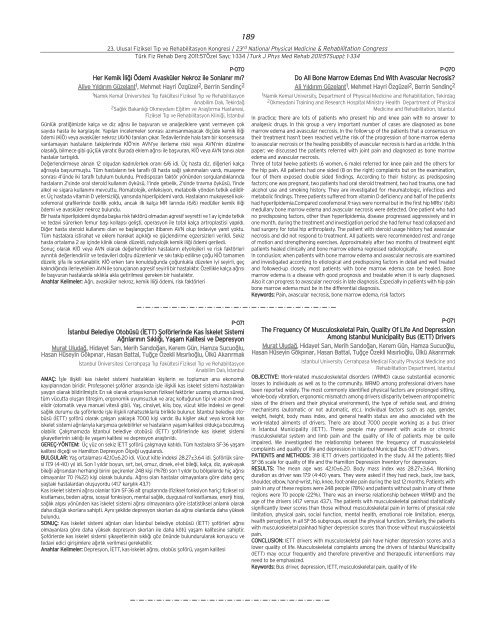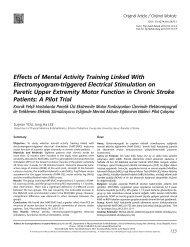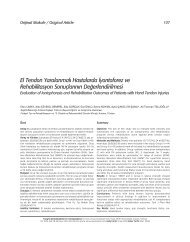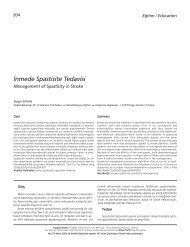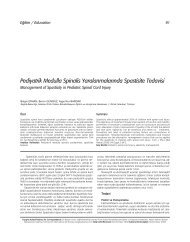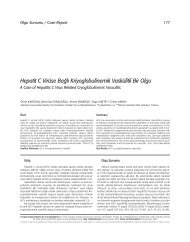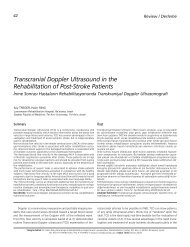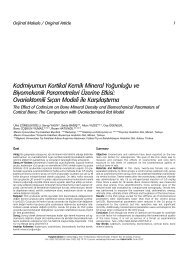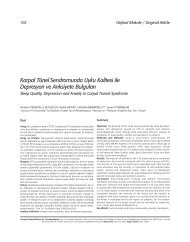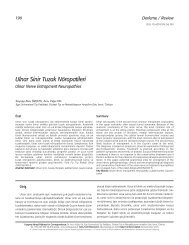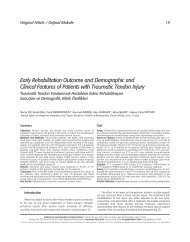‹nmeli Hastalarda Yaflflam Kalitesini Etkileyen ... - FTR Dergisi
‹nmeli Hastalarda Yaflflam Kalitesini Etkileyen ... - FTR Dergisi
‹nmeli Hastalarda Yaflflam Kalitesini Etkileyen ... - FTR Dergisi
Create successful ePaper yourself
Turn your PDF publications into a flip-book with our unique Google optimized e-Paper software.
189<br />
23. Ulusal Fiziksel T›p ve Rehabilitasyon Kongresi / 23 rd National Physical Medicine & Rehabilitation Congress<br />
Türk Fiz Rehab Derg 2011:57Özel Say›; 1-334 /Turk J Phys Med Rehab 2011:57Suppl; 1-334<br />
P-070<br />
Her Kemik ‹li¤i Ödemi Avasküler Nekroz ile Sonlan›r m›?<br />
Aliye Y›ld›r›m Güzelant 1, Mehmet Hayri Özgüzel 2, Berrin Sendinç 2<br />
1Nam›k Kemal Üniversitesi T›p Fakültesi Fiziksel T›p ve Rehabilitasyon<br />
Anabilim Dal›, Tekirda¤<br />
2Sa¤l›k Bakanl›¤› Okmeydan› E¤itim ve Araflt›rma Hastanesi,<br />
Fiziksel T›p ve Rehabilitasyon Klini¤i, ‹stanbul<br />
Günlük prati¤imizde kalça ve diz a¤r›s› ile baflvuran ve analjeziklere yan›t vermeyen çok<br />
say›da hasta ile karfl›lafl›l›r. Yap›lan incelemeler sonras› az›msanmayacak ölçüde kemik ili¤i<br />
ödemi (K‹Ö) veya avasküler nekroz (AVN) tan›lar› ç›kar. Tedavilerinde hala tam bir konsensusa<br />
var›lamayan hastalar›n takiplerinde K‹Ö’nin AVN’ye ilerleme riski veya AVN’nin düzelme<br />
olas›l›¤›, bilmece gibi güçlük yarat›r. Burada eklem a¤r›s› ile baflvuran, K‹Ö veya AVN tan›s› alan<br />
hastalar tart›fl›ld›.<br />
De¤erlendirmeye al›nan 12 olgudan kad›n/erkek oran› 6/6 idi. Üç hasta diz, di¤erleri kalça<br />
a¤r›s›yla baflvurmufltu. Tüm hastalar›n tek tarafl› (8 hasta sa¤) yak›nmalar› vard›, muayene<br />
sonras› 4’ünde iki tarafl› tutulum bulundu. Predispozan faktör yönünden sorguland›klar›nda<br />
hastalar›n 2’sinde oral steroid kullan›m öyküsü, 1’inde gebelik, 2’sinde travma öyküsü, 1’inde<br />
alkol ve sigara kullan›m› mevcuttu. Romatolojik, enfeksiyon, metabolik yönden tetkik edildiler.<br />
Üç hastada vitamin D yetersizli¤i, yar›s›nda hiperlipidemi vard›. Hastalar›n mukayeseli koksofemoral<br />
grafilerinde özellik yoktu, ancak ilk kalça MR lar›nda (6/6) medüller kemik ili¤i<br />
ödemi ve avasküler nekroz bulundu.<br />
Bir hasta hiperlipidemi d›fl›nda baflka risk faktörü olmadan agresif seyretti ve 1 ay içinde tetkik<br />
ve tedavi sürerken femur bafl› kollaps› geliflti, operasyon ile total kalça artroplastisi yap›ld›.<br />
Di¤er hasta steroid kullan›m› olan ve bafllang›çtan itibaren AVN olup tedaviye yan›t yoktu.<br />
Tüm hastalara istirahat ve eklem hareket aç›kl›¤› ve güçlendirme egzersizleri verildi. Sekiz<br />
hasta ortalama 2 ay içinde klinik olarak düzeldi, radyolojik kemik ili¤i ödemi geriledi.<br />
Sonuç olarak K‹Ö veya AVN olarak de¤erlendirilen hastalar›n etyolojileri ve risk faktörleri<br />
ayr›nt›l› de¤erlendirilir ve tedavileri do¤ru düzenlenir ve s›k› takip edilirse ço¤u K‹Ö tamamen<br />
düzelir, flifa ile sonlanabilir. K‹Ö erken tan› konuldu¤unda ço¤unlukla düzelen iyi seyirli, geç<br />
kal›nd›¤›nda ilerleyebilen AVN ile sonuçlanan agresif seyirli bir hastal›kt›r. Özellikle kalça a¤r›s›<br />
ile baflvuran hastalarda s›kl›kla akla getirilmesi gereken bir hastal›kt›r.<br />
Anahtar Kelimeler: A¤r›, avasküler nekroz, kemik ‹li¤i ödemi, risk faktörleri<br />
P-071<br />
‹stanbul Belediye Otobüsü (‹ETT) fioförlerinde Kas ‹skelet Sistemi<br />
A¤r›lar›n›n S›kl›¤›, Yaflam Kalitesi ve Depresyon<br />
Murat Uluda¤, Hidayet Sar›, Merih Sar›do¤an, Kerem Gün, Hamza Sucuo¤lu,<br />
Hasan Hüseyin Gökp›nar, Hasan Battal, Tu¤çe Özekli M›s›rl›o¤lu, Ülkü Akar›rmak<br />
‹stanbul Üniversitesi Cerrahpafla T›p Fakültesi Fiziksel T›p ve Rehabilitasyon<br />
Anabilim Dal›, ‹stanbul<br />
AMAÇ: ‹flle iliflkili kas iskelet sistemi hastal›klar› kiflilerin ve toplumun ana ekonomik<br />
kay›plar›ndan biridir. Profesyonel floförler aras›nda iflle iliflkili kas iskelet sistemi hastal›klar›<br />
yayg›n olarak bildirilmifltir. En s›k olarak ortaya konan fiziksel faktörler uzam›fl oturma süresi,<br />
tüm vücutta oluflan titreflim, ergonomik uyumsuzluk ve araç koltu¤unun tipi ve arac›n modelidir<br />
(otomatik veya manuel vitesli gibi). Yafl, cinsiyet, kilo, boy, vücut kitle indeksi ve genel<br />
sa¤l›k durumu da floförlerde iflle iliflkili rahats›zl›klarla birlikte bulunur. ‹stanbul belediye otobüsü<br />
(‹ETT) floförü olarak çal›flan yaklafl›k 7000 kifli vard›r. Bu kifliler akut veya kronik kas<br />
iskelet sistemi a¤r›lar›yla karfl›m›za gelebilirler ve hastalar›n yaflam kalitesi oldukça bozulmufl<br />
olabilir. Çal›flmam›zda ‹stanbul belediye otobüsü (‹ETT) floförlerinde kas iskelet sistemi<br />
flikayetlerinin s›kl›¤› ile yaflam kalitesi ve depresyon araflt›r›ld›.<br />
GEREÇ-YÖNTEM: Üç yüz on sekiz ‹ETT floförü çal›flmaya kat›ld›. Tüm hastalara SF-36 yaflam<br />
kalitesi ölçe¤i ve Hamilton Depresyon Ölçe¤i uyguland›.<br />
BULGULAR: Yafl ortalamas› 42.10±6.20 idi. Vücut kitle indeksi 28.27±3.64 idi. fioförlük süresi<br />
17.9 (4-40) y›l idi. Son 1 y›ld›r boyun, s›rt, bel, omuz, dirsek, el-el bile¤i, kalça, diz, ayak-ayak<br />
bile¤i a¤r›s›ndan herhangi birini geçirenler 248 kifli (%78) son 1 y›ld›r bu bölgelerde hiç a¤r›s›<br />
olmayanlar 70 (%22) kifli olarak bulundu. A¤r›s› olan hastalar olmayanlara göre daha genç<br />
yafltaki hastalardan olufluyordu (41.7 karfl›l›k 43.7)<br />
Kas iskelet sistemi a¤r›s› olanlar tüm SF-36 alt gruplar›nda (fiziksel fonksiyon hariç) fiziksel rol<br />
k›s›tlamas›, beden a¤r›s›, sosyal fonksiyon, mental sa¤l›k, duygusal rol k›s›tlamas›, enerji hissi,<br />
sa¤l›k alg›s› yönünden kas iskelet sistemi a¤r›s› olmayanlara göre istatistiksel anlaml› olarak<br />
daha düflük skorlara sahipti. Ayn› flekilde depresyon skorlar› da a¤r›s› olanlarda daha yüksek<br />
bulundu.<br />
SONUÇ: Kas iskelet sistemi a¤r›lar› olan ‹stanbul belediye otobüsü (‹ETT) floförleri a¤r›s›<br />
olmayanlara göre daha yüksek depresyon skorlar› ile daha kötü yaflam kalitesine sahiptir.<br />
fioförlerde kas iskelet sistemi flikayetlerinin s›kl›¤› göz önünde bulundurularak koruyucu ve<br />
tedavi edici giriflimlere a¤›rl›k verilmesi gerekebilir.<br />
Anahtar Kelimeler: Depresyon, ‹ETT, kas-iskelet a¤r›s›, otobüs floförü, yaflam kalitesi<br />
P-070<br />
Do All Bone Marrow Edemas End With Avascular Necrosis?<br />
Ali Y›ld›r›m Güzelant 1, Mehmet Hayri Özgüzel 2, Berrin Sendinç 2<br />
1 Namik Kemal University, Department of Physical Medicine and Rehabilitation, Tekirdag<br />
2 Okmeydani Training and Research Hospital Ministry Health Department of Physical<br />
Medicine and Rehabilitation, Istanbul<br />
In practice; there are lots of patients who present hip and knee pain with no answer to<br />
analgesic drugs. In this group a very important number of cases are diagnosed as bone<br />
marrow edema and avascular necrosis. In the follow-up of the patients that a consensus on<br />
their treatment hasn’t been reached yet,the risk of the progression of bone marrow edema<br />
to avascular necrosis or the healing possibility of avascular necrosis is hard as a riddle. In this<br />
paper; we discussed the patients referred with joint pain and diagnosed as bone marrow<br />
edema and avascular necrosis.<br />
Three of total twelve patients (6 women, 6 male) referred for knee pain and the others for<br />
the hip pain. All patients had one sided (8 on the right) complaints but on the examination,<br />
four of them exposed double sided findings. According to their history; as predisposing<br />
factors; one was pregnant, two patients had oral steroid treatment, two had trauma, one had<br />
alcohol use and smoking history. They are investigated for rheumatologic, infectious and<br />
metabolic findings. Three patients suffered from vitamin D deficiency and half of the patients<br />
had hyperlipidemia.Compared coxofemoral X-rays were normal but in the first hip MRIs’ (6/6)<br />
medullary bone marrow edema and avascular necrosis were detected. One patient who had<br />
no predisposing factors, other than hyperlipidemia, disease progressed aggressively and in<br />
one month, during the treatment and investigation period she had femur head collapsed and<br />
had surgery for total hip arthroplasty. The patient with steroid usage history had avascular<br />
necrosis and did not respond to treatment. All patients were recommended rest and range<br />
of motion and strengthening exercises. Approximately after two months of treatment eight<br />
patients healed clinically and bone marrow edema regressed radiologically.<br />
In conclusion; when patients with bone marrow edema and avascular necrosis are examined<br />
and investigated according to etiological and predisposing factors in detail and well treated<br />
and followed-up closely, most patients with bone marrow edema can be healed. Bone<br />
marrow edema is a disease with good prognosis and treatable when it is early diagnosed.<br />
Also it can progress to avascular necrosis in late diagnosis. Especially in patients with hip pain<br />
bone marrow edema must be in the differential diagnosis.<br />
Keywords: Pain, avascular necrosis, bone marrow edema, risk factors<br />
P-071<br />
The Frequency Of Musculoskeletal Pain, Quality Of Life And Depression<br />
Among Istanbul Municipality Bus (IETT) Drivers<br />
Murat Uluda¤, Hidayet Sar›, Merih Sar›do¤an, Kerem Gün, Hamza Sucuo¤lu,<br />
Hasan Hüseyin Gökp›nar, Hasan Battal, Tu¤çe Özekli M›s›rl›o¤lu, Ülkü Akar›rmak<br />
Istanbul University Cerrahpasa Medical Faculty Physical Medicine and<br />
Rehabilitation Department, Istanbul<br />
OBJECTIVE: Work-related musculoskeletal disorders (WRMD) cause substantial economic<br />
losses to individuals as well as to the community. WRMD among professional drivers have<br />
been reported widely. The most commonly identified physical factors are prolonged sitting,<br />
whole-body vibration, ergonomic mismatch among drivers (disparity between antropometric<br />
sizes of the drivers and their physical environment), the type of vehicle seat, and driving<br />
mechanisms (automatic or not automatic, etc.). Individual factors such as age, gender,<br />
weight, height, body mass index, and general health status are also associated with the<br />
work-related ailments of drivers. There are about 7000 people working as a bus driver<br />
in ‹stanbul Municipality (IETT). These people may present with acute or chronic<br />
musculoskeletal system and limb pain and the quality of life of patients may be quite<br />
impaired. We investigated the relationship between the frequency of musculoskeletal<br />
complaints and quality of life and depression in Istanbul Municipal Bus (IETT) drivers.<br />
PATIENTS and METHODS: 318 IETT drivers participated in the study. All the patients filled<br />
SF-36 scale for quality of life and the Hamilton Depression Inventory for depression.<br />
RESULTS: The mean age was 42.10±6.20. Body mass index was 28.27±3.64. Working<br />
duration as driver was 17.9 (4-40) years. They were asked if they had neck, back, low back,<br />
shoulder, elbow, hand-wrist, hip, knee, foot-ankle pain during the last 12 months. Patients with<br />
pain in any of these regions were 248 people (78%) and patients without pain in any of these<br />
regions were 70 people (22%). There was an inverse relationship between WRMD and the<br />
age of the drivers (41.7 versus 43.7). The patients with musculoskeletal painhad statistically<br />
significantly lower scores than those without musculoskeletal pain in terms of physical role<br />
limitation, physical pain, social function, mental health, emotional role limitation, energy,<br />
health perception, in all SF-36 subgroups, except the physical function. Similarly, the patients<br />
with musculoskeletal painhad higher depression scores than those without musculoskeletal<br />
pain.<br />
CONCLUSION: IETT drivers with musculoskeletal pain have higher depression scores and a<br />
lower quality of life. Musculoskeletal complaints among the drivers of Istanbul Municipality<br />
(IETT) may occur frequently and therefore preventive and therapeutic interventions may<br />
need to be emphasized.<br />
Keywords: Bus driver, depression, IETT, musculoskeletal pain, quality of life


